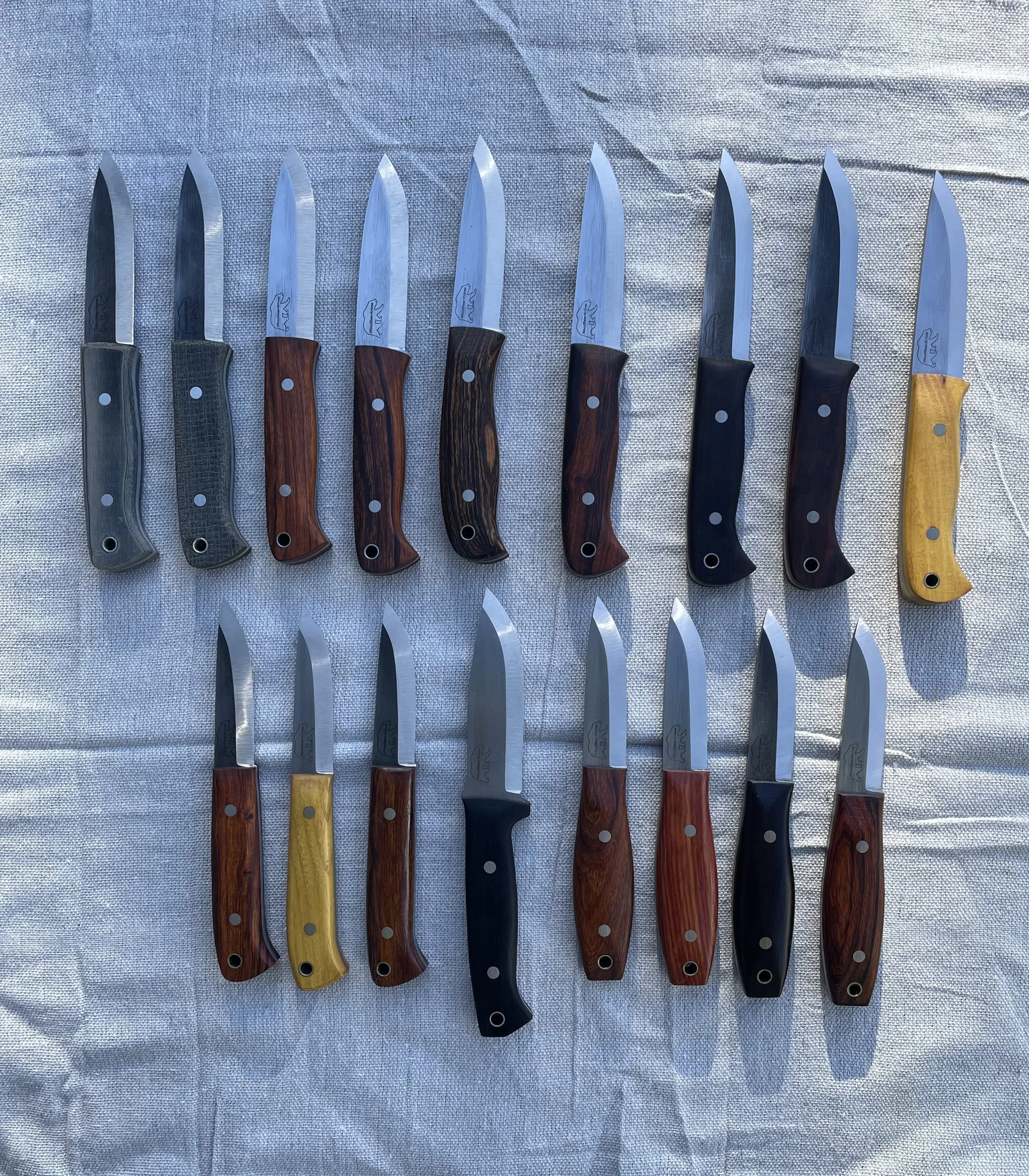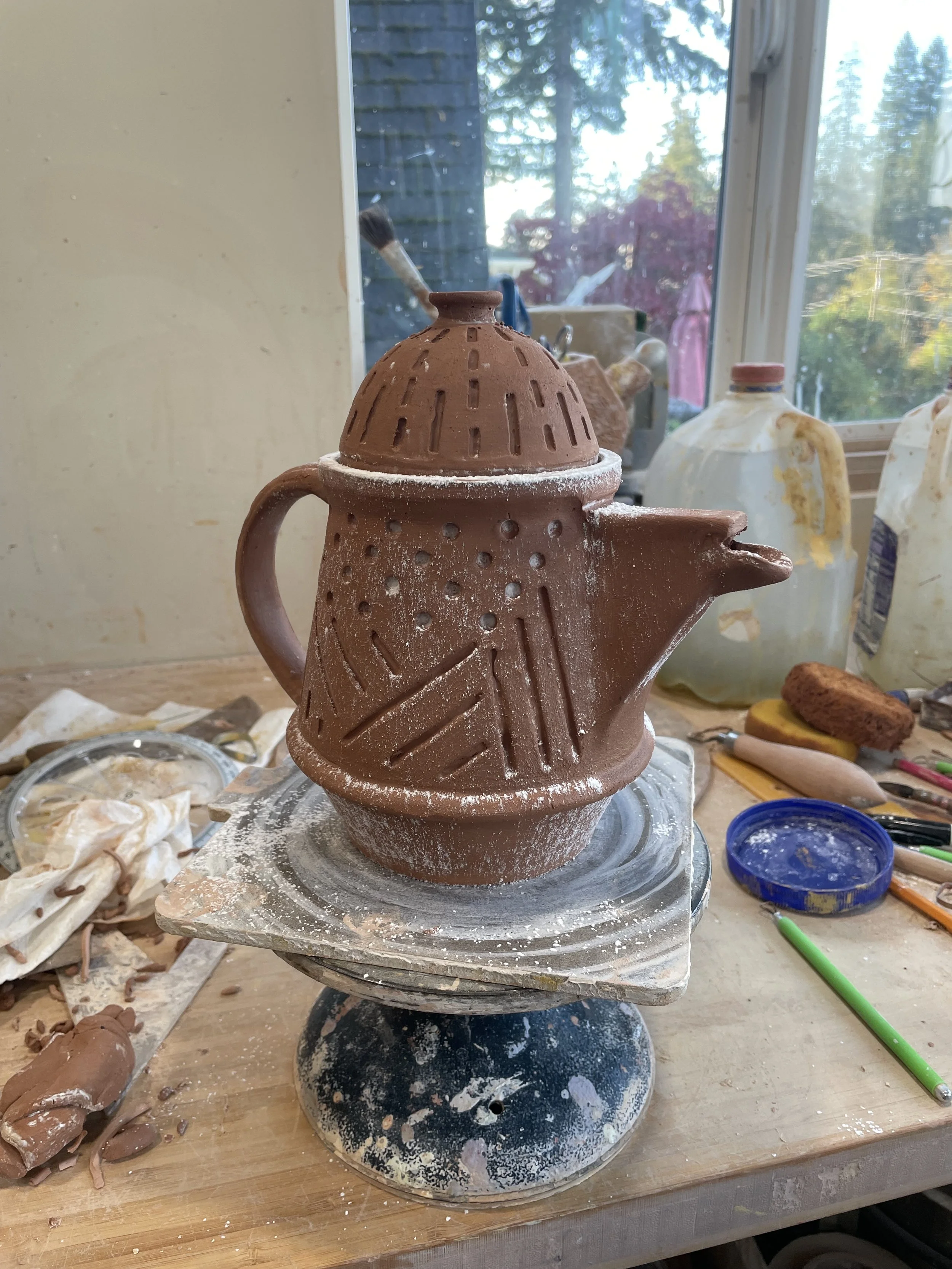Crafting Our Lives: The Art We're Taking with Us
When people ask what we'll do in France, the practical answers come easily: Lelaine will teach English, we'll explore Montpellier, we'll learn the language. But the real answer, the one that lives deeper, is this: we'll create.
We're makers. It's not just what we do—it's who we are. And France, with its centuries-old tradition of honoring craft and artisanship, feels like a place where that part of us can not only continue but flourish.
Andras: From Steel to Clay
I spent over a decade as a knife maker. Built a business, traveled to shows and fairs, shipped my work all over the world. It was good work, work I was proud of. But when illness brought me to Lelaine's home and her mother encouraged me to try pottery, something shifted.
At first, it was just something to do in my downtime. But slowly, it became therapeutic, meditative—a place where my mind could disconnect from life's problems and just be present with the clay.
The difference between working with steel and working with clay surprised me. In knife making, if I messed up a grind, sometimes it wasn't salvageable. It became trash. But with pottery, if I mess up a throw—if something was on my mind and the piece goes sideways—the clay simply shows me a different item. It says, "Okay, so this is what you want to be," and I create something else.
Clay is alive in a way steel never was. I feel more connected to it. My creativity shows itself better here, more freely.
I've made around a hundred pieces now. Among my favorites are some mugs and bigger bowls that turned out exactly as I imagined them—like a large peacock-style glazed bowl, all those colors and flowing glazes melting into each other. Just awesome to look at. I love working on pieces that require attention: stamping, carving, detail work, repeating patterns. I'm tilting toward a more artsy, unusual type of creation.
What happens to all of them I’m not sure at this point.
We'll sell (hopefully) most of the pieces before we go, though I wouldn't mind taking a few with us. I'll bring some small shaping and carving tools, maybe some of my favorite glazes. But the wheel, the studio, the collection I've built—that all stays here.
It stings a little, but I know I can make more in France. That's part of the dream, actually.
I picture myself grabbing a cup of coffee at our favorite place in Montpellier—maybe with some freshly made pastry—and then heading to a community studio. Spending a few hours there, working and socializing with like-minded people. It'll be a great way to practice French, too. Or I'll accompany Lelaine to the beach or a favorite square, just hang out and see what inspiration shows up.
What I'll miss most is the talks with Lelaine's mom about how to do something, getting advice or ideas from her, or those moments when I was excited to show her my new pieces. I'll miss the studio for sure. But hopefully, we'll find a new creative home in Montpellier.
Lelaine: The Soul of Paper and Thread
My art is different from Andras'—quieter, more layered, built from fragments and memory.
I make junk journals and altered books. A junk journal is a handmade book created from a mix of new and recycled materials: old book pages, envelopes, fabric scraps, maps, postcards, lace, decorative papers. It's used for writing, art, memory keeping, or creative expression. Each one is a one-of-a-kind creation, thoughtfully layered with tags, pockets, lace trims, and tuck spots for notes, photos, and keepsakes.
Creating a junk journal is a slow, soulful process for me. It's part treasure hunt, part meditation, part storytelling.
Each journal begins long before I touch any paper. I start by collecting materials that speak to me—old book pages with yellowed edges, bits of lace, forgotten letters, vintage paper products like postcards and stamps. Sometimes it's one single image that inspires me or sparks a theme.
Then I begin with a base: an old cereal or makeup box, an old book cover, a file folder. I've always loved giving old things a second life.
Next comes the layering—tea-stained sheets, vellum, ledger paper, envelopes, anything that feels right in my hands. Sometimes I add stitching, pockets, or tuck spots for secret notes or photos. I don't plan it much. I let the papers guide me.
Then the magic happens. I add texture with lace, ribbon, buttons, wax seals, bits of ephemera. I stencil, stamp, ink, paint.
When all the pages feel ready, I bind them by hand, usually using waxed thread and a simple stitch. This step always feels sacred to me—like sewing the soul of the book together.
I flip through every page a time or two, making sure there are surprises tucked inside: a secret tag, a quote, a pressed flower. I want each journal to feel like a journey waiting to be discovered.
When I finish, I sit with it for a while. This is where it becomes difficult to let them go. But once it feels complete, I'm ready to release it to the world. Each journal carries a little piece of me, but it's meant to hold someone else's story next.
What I'm Leaving, What I'm Taking
Downsizing my craft supplies might be one of the hardest parts of this move.
I've spent years collecting supplies from local secondhand stores and sales. Each scrap of paper, ribbon, fabric, or stamp I've chosen with care. I know how they feel in my hands and how they look when I layer them. My art supplies have always brought me calm and familiarity.
I'm specifically worried about finding old books in English that I've collected. I know there's plenty of ephemera in France—fabrics and laces I can find in vintage stores and markets—but my inks and papers may be more difficult to replace. I know secondhand stores like Goodwill and St. Vincent de Paul are different in France.
I'll be creating a spreadsheet: supplies I'm taking, supplies I'm selling. It will be difficult, but I know it must be done.
Creating in France
Still, the thought of what awaits excites me more than what I'm leaving behind.
I picture myself shopping at local flea markets, antique shops, and bookshops, finding French aesthetics to add to newly dreamed journals. In these, I'll include French language alongside my native English. I'm excited to use French nature as my muse—collecting flowers to press, taking rubbings from old stone walls or iron fences.
I look forward to sitting in a town square, sketching old buildings and people as I watch this new life unfold in front of me.
I'm looking forward to having a creative space in our home where I can focus on making my art. Going to local cafés and sketching ideas for my next journal. Going to the beach and working on other types of creativity I shelved years ago.
I'd also like to see if there's a market for my journals in France—either selling at a market or through an online platform once I have more items available.
Creativity and Teaching
I've often considered how to connect my art with my teaching, and lately, I've been discovering it works beautifully.
I learn best when things are hands-on, and I've found in my recent student teaching that many students do too. When they add a touch of themselves to their projects, they're more likely to finish them—and they feel proud showing their work.
I have visions of teaching English through creativity: finding old ephemera like mysterious postcards and having students write the story behind them, comparing aspects of English-speaking cultures with their own using maps, travel photos, menus, and postcards. Sometimes I feel like I'm bubbling over with excitement about how I want to teach.
Creating Together
Right now, with school and preparation consuming so much of our time, we mostly create separately. We talk about working on ceramics together—Lelaine has real talent with glazing and sculpting—but we haven't had the time yet.
Lelaine: I tried teaching Andras about altering books once, but I think he wasn't as interested once we started, which is completely fine. He excels in the crafts he does, and watching him create is amazing. I hope when we get to France, we'll have more time to co-create.
Andras: I think right now she's just too busy with schoolwork—which is cool—to work on anything together, but I really like the idea. Using her glazing and sculpting skills (she's great) on some projects together, I'm sure it would be fun. Once we're settled in Montpellier, I can see us collaborating more—her eye for detail and color combined with my wheel work could make some really interesting pieces.
For now, we inspire each other just by being present in each other's creative worlds. But France feels like it will give us the space and time to finally create side by side.
The French Artisan Dream
We're both drawn to France partly because of how deeply the culture values art, education, crafts, music, writing, and creation.
I'm excited about Montpellier's art scene specifically. We watched a video where a group of women were painting pictures of a local fountain in the middle of a town square. That thrilled me—I look forward to finding similar groups, sitting with other artists, and being part of a creative community.
Andras has already researched the pottery scene and found a few places where we can get involved. The idea of drawing inspiration from the city, the landscape, fellow potters, and local markets keeps us motivated through the harder moments of preparation.
We both dream of eventually selling our work—Andras creating pieces for our home first, then later making items for markets; me building up a collection of journals to sell, either at markets or online.
But more than selling, we dream of simply being in a place that honors what we do. Where craft isn't a hobby squeezed into the margins of a busy American life, but something woven into the rhythm of daily living.
What We're Leaving Behind
The community I'm leaving behind isn't large—mostly the local craft store I worked at this summer with my daughter Arianna. While that's difficult, it was only a summer job. Still, knowing they have products I enjoy using will be hard to leave. I'll stay in touch, though, and maybe I'll be able to send them French-themed journals to sell in the store.
For Andras, the loss is more personal. He'll miss the talks with my mom about pottery—getting advice, sharing ideas, showing her his new pieces. He'll miss the studio. But we both know we're not leaving our creative selves behind. We're carrying them with us.
The Art We're Taking
Not much, in terms of physical objects. A few mugs. Some tools. Carefully chosen supplies.
But we're taking everything that matters: the skills we've spent years developing, the creative spirits that define us, the belief that a life built around making things is a life worth living.
France feels like a place that understands that. A place where artisans aren't just tolerated—they're celebrated. Where markets overflow with handmade goods, where studios hum with quiet focus, where taking time to create something beautiful isn't seen as indulgent but essential.
We're not just moving to France. We're moving toward a life where our hands, our hearts, and our creativity have room to breathe.
And that's worth every box we're leaving behind.

